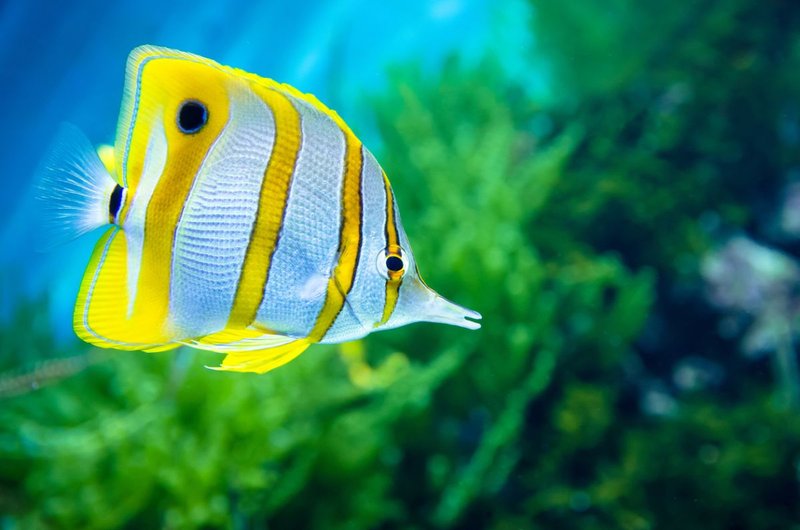
In this article, we’ll dive into common health problems that butterflyfish encounter and, more importantly, how you can prevent these issues. Whether you’re managing a home aquarium or a larger marine tank, understanding these challenges can help you create a thriving environment for your aquatic friends.
Understanding the Unique Needs of Butterflyfish
Before we can tackle health problems, let’s talk about what these fish need to flourish. Butterflyfish thrive in healthy coral reef settings, where they can find plenty of hiding spots, food sources, and social interactions. These habitats are crucial in mimicking their natural environment.
You might be wondering, “What does that mean for my tank?” Well, creating a reef-like environment requires more than just adding fish. You’ll want to consider factors like water quality, tank mates, and stress levels. Keeping the water clean and stable is key. Butterflyfish are sensitive to changes in temperature, salinity, and pH levels, so regular testing and maintenance are a must.
Here’s a quick checklist to ensure your butterflyfish thrive:
- Stable water temperature (generally 74-78°F)
- Salinity levels around 1.020-1.025
- Balanced pH (8.1 to 8.4)
- Filtered water with low ammonia and nitrite levels
Common Health Issues: Ich (Marine Ich)
One of the most notorious problems for butterflyfish is Ich, or marine ich. This is a parasitic infection that causes white spots on the fish’s body, looking a bit like sprinkled salt. Ich can be especially harmful because it can lead to more severe stress or even death if not treated promptly.
So, how does a fish catch ich? Often, it’s a result of stress—like recent tank changes or aggressive tank mates. If you see your butterflyfish scratching itself against rocks or decorations, that could be a red flag.
To prevent ich, maintain a stable tank environment and monitor your fish for signs of stress. If you notice any symptoms, consider a quarantine tank and treatment options like copper-based medications or hyposalinity. Always remember, prevention is key, so keep that water clean and your fish happy!
Preventing and Managing Fin Rot
Another common issue with butterflyfish is fin rot, which is usually caused by poor water quality and stress. It can start with slight discoloration on the fins and develop into more severe decay if not addressed quickly. Think of it like a small paper cut that gets infected—the longer you leave it untreated, the worse it becomes.
The best way to prevent fin rot is to maintain your tank regularly. Clean the substrate, perform partial water changes, and check for excess waste. Additionally, ensure your butterflies aren’t getting bullied by tank mates, which can lead to stress and health problems.
If you do notice signs of fin rot, act fast. You can treat it with antibacterial medications and focus on improving water conditions. Sometimes, a little extra care can go a long way.
Nutritional Deficiencies and Their Impact
Feeding your butterflyfish a balanced diet is crucial. These fish are known for their picky eating habits, but a poor diet can lead to nutritional deficiencies. This usually shows up as lethargy, fading colors, or even issues with growth.
You might be thinking, “What do I feed them?” Incorporating high-quality flakes, frozen foods, and marine algae can help maintain their health. Variety is vital!
To prevent nutritional issues:
- Offer a mix of spirulina, high-protein foods, and live or frozen offerings.
- Observe your fish during feeding to ensure they’re eating well.
- Consider additional vitamins or supplements if necessary.
Lastly, remember to avoid overfeeding. It’s better for your fish to eat smaller portions multiple times a day rather than large amounts at once.
Stress Management for Butterflyfish
Stress is a silent killer in the fishkeeping world. For butterflyfish, stress can manifest from various sources, including tank overcrowding, aggressive tank mates, or sudden changes in water conditions. Imagine if you were suddenly moved to a noisy, chaotic environment; you’d probably feel on edge too.
To keep butterflyfish stress-free, focus on creating a peaceful atmosphere. Choose compatible tank mates wisely and provide plenty of hiding spots. Good water quality also plays a significant role, so keep up with your tank maintenance.
If you see signs of stress, like rapid gill movement or erratic swimming, try to identify the source. It might be time to rearrange decorations, separate aggressive fish, or even invest in a larger tank.
Understanding Swim Bladder Disease
Swim bladder disease can affect butterflyfish and other marine species, leading to buoyancy issues. Affected fish may float upside down or struggle to stay submerged. This condition can cause significant distress and often stems from overfeeding or poor water quality.
Preventing swim bladder disease revolves around a balanced diet and stable tank conditions. Start by moderating feeding amounts and ensuring your fish get a good mix of foods.
If you suspect swim bladder disease, there are a few steps you can take:
- Fast your fish for a day or two to help flush their system.
- Introduce high-fiber foods, like blanched peas, to aid digestion.
- Ensure water quality is optimal to reduce stress factors.
Caring for butterflyfish can be a rewarding experience, but it comes with its share of challenges. By understanding the common health problems and how to prevent them, you’re setting yourself and your fish up for success. Remember to focus on creating a comfortable habitat, maintaining water quality, and providing a balanced diet. With these practices, you can enjoy the beauty of your butterflyfish for years to come.
Taking the time to learn about their needs not only enhances their lives but makes your aquarium experience much more enjoyable. So, dive in and give your butterflyfish the care they deserve!

